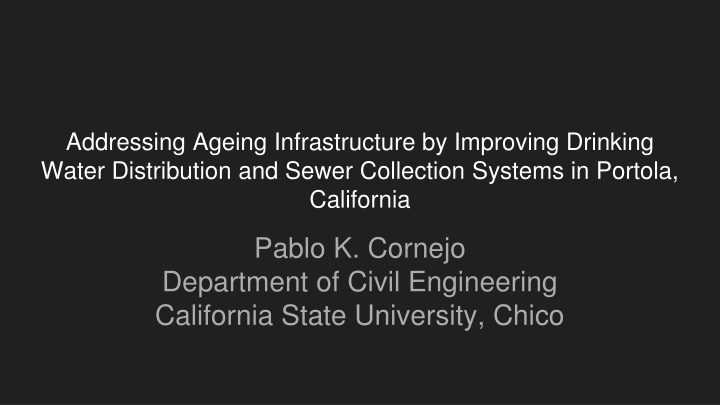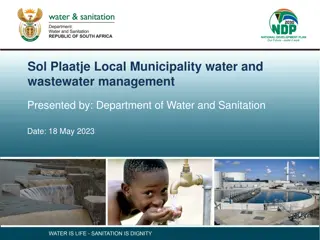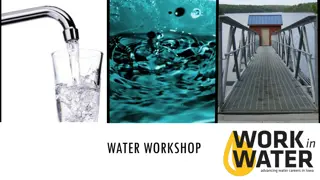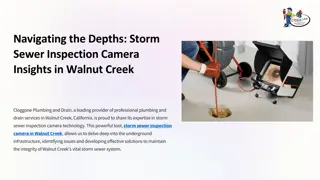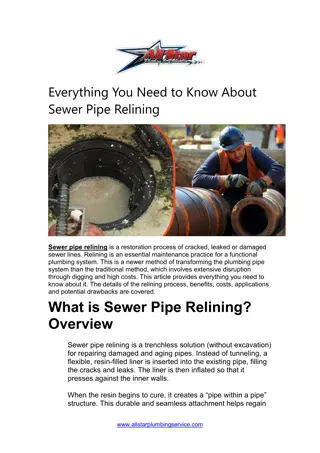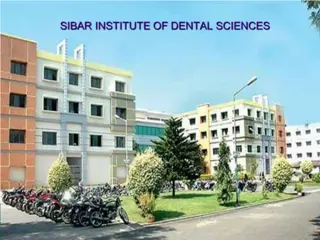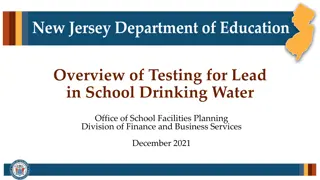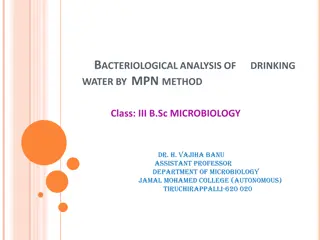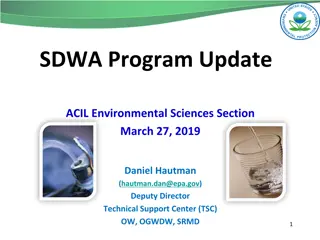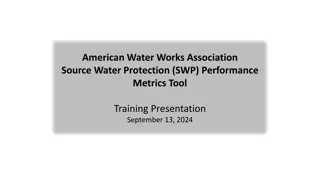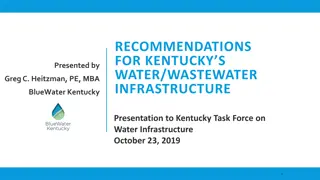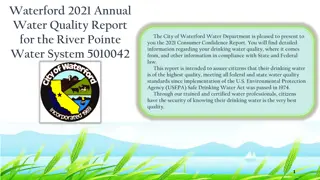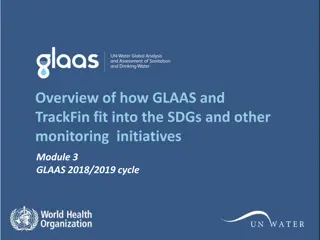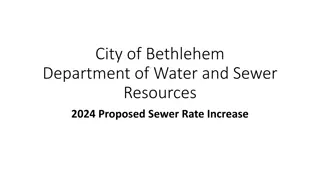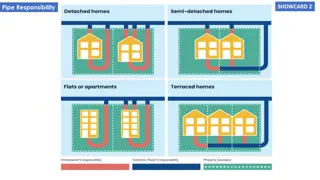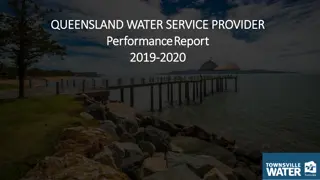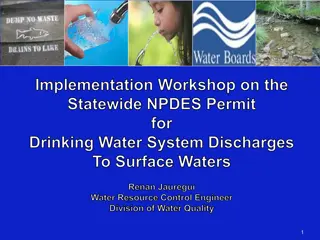Improving Drinking Water Distribution and Sewer Collection Systems in Portola, California
Addressing the ageing infrastructure challenges in Portola, California through the improvement of drinking water distribution and sewer collection systems. The project aims to overcome issues related to antiquated piping, material concerns, and water quality to enhance public health and safety.
Download Presentation

Please find below an Image/Link to download the presentation.
The content on the website is provided AS IS for your information and personal use only. It may not be sold, licensed, or shared on other websites without obtaining consent from the author.If you encounter any issues during the download, it is possible that the publisher has removed the file from their server.
You are allowed to download the files provided on this website for personal or commercial use, subject to the condition that they are used lawfully. All files are the property of their respective owners.
The content on the website is provided AS IS for your information and personal use only. It may not be sold, licensed, or shared on other websites without obtaining consent from the author.
E N D
Presentation Transcript
Addressing Ageing Infrastructure by Improving Drinking Water Distribution and Sewer Collection Systems in Portola, California Pablo K. Cornejo Department of Civil Engineering California State University, Chico
Outline Background Motivation Goals Economic Analysis Results Conclusions Ongoing Work
Introduction City of Portola: economically disadvantaged community in Northern California ~2,000 residents Challenges with ageing infrastructure Water distribution and sewer collection Reaching life expectancy High risk of failure
Key Challenges Antiquated piping system Limited upgrades since 1950s Piping materials of concern Asbestos cement pipe 52% of total length (water) Water quality and quantity concerns (I&I)
Background WRPI s Center for Disadvantaged Communities Engaging CSU engineering students on technical assistance project aimed at improving water and wastewater infrastructure through Proposition 1 Funding Technical Assistance Group Executive Director of WRPI Boykin Witherspoon III Project managers, WRPI senior personnel, and staff Roger Shintaku, Tim Clark, Sargent Green, Melissa Moreno, Tamra Fukumoto CSU faculty Jackson Webster, Pablo K. Cornejo, Marie E. Patterson WRPI staff and CSU students: Uriel Dominguez, Andres Ramirez, Aurora Diaz, Jonathan Campos, Dylan De Leon, Mekena Galka, Wesley Miller, Ethan Retherford, Dylan Yamasaki, Jason Blum, Nicholas Mclean, Benjamin Nichols, Rafael Cervantes, Natali van Leeuwen, Karen Martinez, Holly Stein, Alec Dominguez
Big Picture City willingness to borrow & limitations on state grant amount CWSRF Alternative DWSRF Alternative Preliminary design of alternatives considered - Mapping - Trench dimensions - Selection of materials Preliminary design of alternatives considered - Mapping - Trench dimensions - Selection of materials DWSRF development must be in the context of CWSRF DWSRF needs to consider avoided costs related to CWSRF Economic analysis of alternatives and selection Economic analysis of alternatives and selection DWSRF needs to consider overall system reliability, and public interest/safety independent of CWSRF Select project Select project
Project goals Overall goal: Engage CSU engineering students to tackle the project under advising of faculty. This project provides real world problem solving while addressing pressing issues for California communities. The rest of the presentation focuses on cost feasibility of water distribution: Option 1: Limited Action Option 2: Critical Infrastructure Replacements Option 3: Full System Replacement
Option Description Coverage (%) Pros Cons Option 1 Limited Action Replace water lines co- located with CDBG sewer lines proposed to be replaced 14% -New piping reduces risk of breakage during sewer line replacement Limited benefits in: -Public safety -Reliability of social services Option 2 Critical Infrastructure Replace city s water lines in areas with critical infrastructure (hospitals, schools, government buildings) 25% Increases: -Public safety -Reliability of social services Limited benefits in: -Reducing water loss Option 3 Complete System Replacement Complete replacement of water distribution system 100% Maximizes: -Public Safety -Reliability -Higher capital cost -May face challenges in getting approval for funding
Project evaluates Cost and ROCOF Break-in period Risk of Occurrence of Failure Wear-out period Useful life period Time (years) Risk of occurrence of Failure (ROCOF) model. Adapted from Rogers and Grigg, 2009).
Water Distribution Inventory Inventory developed based on existing system Mapping Trench Dimensions Selection of materials Critical infrastructure replacements for south system Construction material and processes were defined: Excavation, demolition, bedding, backfill Piping, valves, elbows, hydrants, asphalt The inventory used for cost estimation Used WaterCAD to assess hydraulic performance
Cost Estimation: RSMeans was used to get estimation for the construction costs Construction material Equipment and labor Operation and maintenance O&M and replacement costs based on historical data Costs avoided based on improvements in system Estimated life cycle costs over 20 years at a 6% discount rate Present Value ($) Equivalent Uniform Annual Cost ($/year)
Life Cycle Cost Analysis (LCCA) LCCA is used to compare the economic impacts of alternatives
Water Distribution Cost Estimate Feasibility Study Critical Infrastructure Replacement Full Cost Summary % of Water Distribution System Limited Action Replacement 14% 26% 100% Replaced: $852,073 $1,383,564 $7,329,686 Northside Capital Cost ($): $678,045 $1,729,491 $4,758,447 Southside Capital Cost ($): $1,530,117 $3,113,055 $12,088,133 Total Capital Cost ($): $903,290 $719,444 $488,248 O&M + Replacement Cost($/year): $11,890,786 $11,365,025 $17,688,297 Present Value (PV): Equivalent Uniform Annual Cost $1,036,693 $990,855 $1,542,146 (EUAC):
Additional costs avoided by concurrent replacement of water and sewer lines ~21% of costs avoided by replacing water and sewer lines concurrently: Mobilization Traffic control Environmental Permitting Cost Avoided for Critical Infrastructure Option. Cost w/ Avoided Costs $2,657,486 $719,444 $10,909,456 $951,136 Critical Infrastructure Total Capital Cost ($): Cost Savings $455,569 $183,846 $2,564,267 $223,564 Operation & Maintenance + Replacement Cost ($/year): Present Value (PV): Equivalent Uniform Annual Cost (EUAC):
Conclusions Option 1 (Limited Action) Least beneficial No concurrent replacement with sewer lines Highest risk of failure Option 2 (Critical Infrastructure): lowest present value Increases benefits to public safety and reliability of critical infrastructure Only 26% of the city covered Option 3 (Full replacement): highest cost Increases benefits to public safety and reliability throughout city Lowest risk of failure
Ongoing Work SewerCAD: hydraulic performance modeling Cost estimate for replacing wastewater collection: RS Means and LCCA Asset Management Plan: long-term economic planning (prioritization) Construction Scheduling: timeline for wastewater improvements CalEEMod: GHG emissions modeling of construction activities PORTOLA PROJECT
